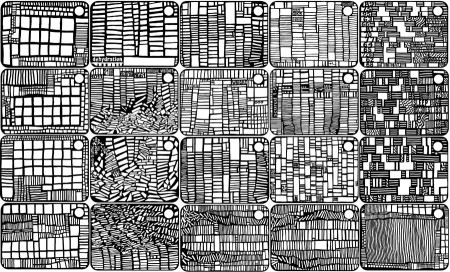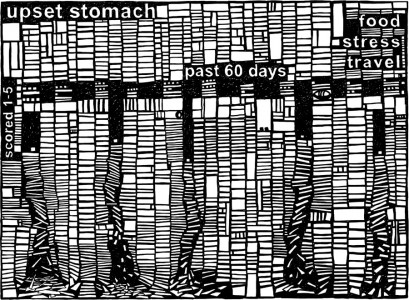How do we ....really count and translate numbers?
/ Have been working hard on the concept of a unique patterned language for self-tracking. There has to be a metaphorical language that translates primal patterns of ourselves. Something far from data visualization or graphical output of data.
Have been working hard on the concept of a unique patterned language for self-tracking. There has to be a metaphorical language that translates primal patterns of ourselves. Something far from data visualization or graphical output of data.
I think the way to come at this is to find a more instinctual approach to numerical cognition. Read about the Amazon tribe that can only count to five - we learn linear representation of numbers from using rulers, tape measures and simple arithmetic....turns out our brains can accurately recognize one, two, three and then it gets fuzzy. Large numbers are totally abstract in our heads, a million, a billion...how many trillion was the (fill-in the blank) war/bailout/deficit?
Young kids estimate numbers on something closer to a logarithmic scale, small quantities are far apart, and then large numbers squish together as they get larger. Just read 'Number Sense: how the mind creates mathematics-updated' by S. Dehaene - he is THE GUY for numerical cognition. And Alex Bellos "Here's looking at Euclid' - interesting, easy ....reads like a Malcolm Gladwell book.
We humans look for patterns, like puzzles, have an intuition for simple arithmetic - there has to be a more intuitive way to convey personal tracking data about ourselves than the line charts and graphs that the gadget companies serve up. Tweet
Beginnings of the 'Quantify-me' installation at the Headlands
/ Totally heads-down at the Headlands....
Have decided the way you figure something out is to take a stab at the idea, and then experiment. Isn't that what scientists do? Hypothesis and then scientific method to test and compare results. Then test again and compare. I can't be sure what the pattern for self-tracking feels like until I just make more, and then more of them.
Totally heads-down at the Headlands....
Have decided the way you figure something out is to take a stab at the idea, and then experiment. Isn't that what scientists do? Hypothesis and then scientific method to test and compare results. Then test again and compare. I can't be sure what the pattern for self-tracking feels like until I just make more, and then more of them.
I'm in the midst of installing a huge room studio size piece at the Headlands Center for the Arts in Sausalito (more on this later, this place is fabulous).
With little distraction at night, have been pouring through books. Loved this one, 'Strangers to Ourselves: Discovering the Adaptive Unconscious" - which questions the notion of the other self, the one who controls our actions beneath conscious thought. Maybe self-tracking is a way to measure and watch the behavior of that other self. Philosophically, what if we're almost entirely controlled by our primal-subconscious .... the one that drives home without remembering anything.
The other books have been about non-western mathematics. Stay tuned.
Sleep, self-tracking and art-making....you can pan/zoom and flip thru the slides quick here
/or click on this link HERE to view it full screen on your machine. All the links work, click freely.
Quantifying-me: what if the the walls produced ambient patterns of how I'm doing?
/ All the good stuff happens while you sleep. If you’re sick, you heal. You build procedural memory, grow taller, resolve conflict, reorder and organize long-term memory. I’ve been measuring my nightly sleep using an EEG headband for over a year, and there is a definite pattern to the brainwaves, with much more activity than you’d imagine. It’s ragged with shorter bursts of deep sleep and REM sleep than I thought. I wake up a lot. It’s weirdly comforting and reaffirming to receive a sleep score everyday. This morning I got a 73, for me it’s about a B+.
All the good stuff happens while you sleep. If you’re sick, you heal. You build procedural memory, grow taller, resolve conflict, reorder and organize long-term memory. I’ve been measuring my nightly sleep using an EEG headband for over a year, and there is a definite pattern to the brainwaves, with much more activity than you’d imagine. It’s ragged with shorter bursts of deep sleep and REM sleep than I thought. I wake up a lot. It’s weirdly comforting and reaffirming to receive a sleep score everyday. This morning I got a 73, for me it’s about a B+.
After building a body of work on sleep patterns and daily activity charts and showing it in Los Angeles. I’ve begun to think about a future where everything can be passively measured. What if walls could produce ambient patterns of how we’re doing, where we subtly adjust behavior in response to those measurements. So, feeling good about quantifying-me, a few months ago I significantly added to the daily regimen. And now measure my weight, how many steps I take, mileage, calories burned, heart rate variability, pulse, my color mood, daily micro-journal of an upset stomach, my tweets, movement of my computer mouse, all web browsing, everything on my laptop, phone data, webstats, my DNA from 23andMe….and realize it’s almost bottomless.
All these self-tracking systems have scores, numbers and infographics….but none seem to match how these activities feel or capture the sensibility of what’s measured. Believing in a connection between visual pattern and brain rhythm, I’ve set out to map a language to convey self-quantifying metrics. Numbers are abstract concepts, but our brains recognize pattern intuitively, I’m working on the vocabulary and grammar of pattern for self-tracking that’s more visceral and direct. It’s work in progress, and harder than it sounds.



